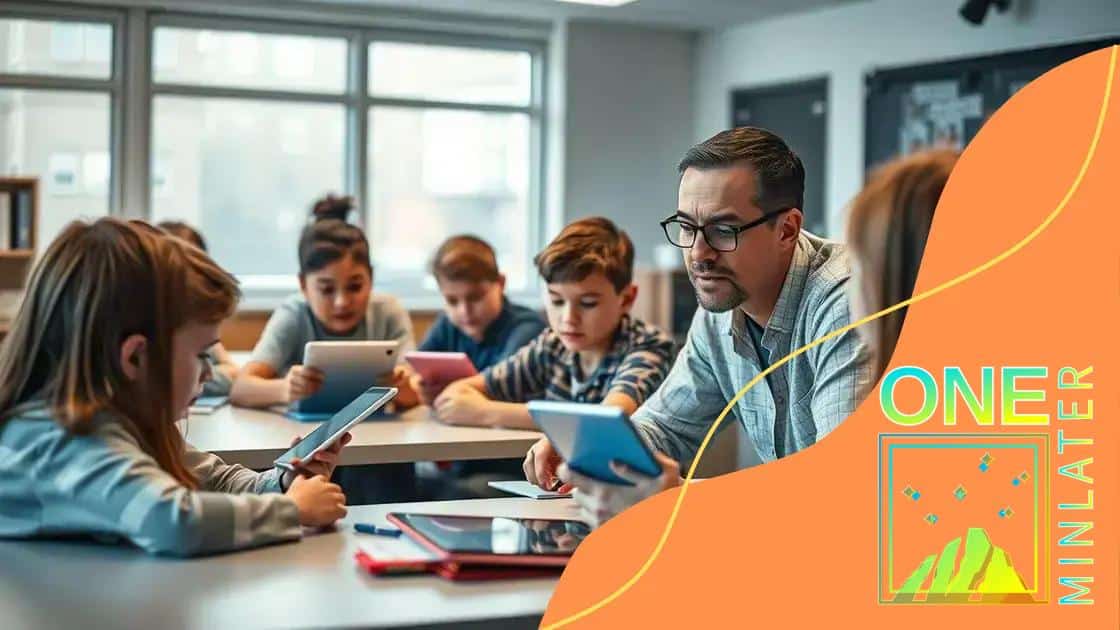How cloud-based classrooms are changing traditional education

Cloud-based classrooms are transforming traditional education by providing personalized learning experiences, improving collaboration, and granting access to diverse educational resources anywhere and anytime.
How cloud-based classrooms are changing traditional education is a topic that sparks curiosity. Imagine a classroom where boundaries disappear and learning happens anytime, anywhere. Let’s dive into this exciting transformation.
Understanding cloud-based classrooms
Understanding cloud-based classrooms is essential in today’s educational landscape. These environments leverage technology to create learning experiences that are both flexible and interactive. By utilizing the cloud, schools can provide resources that enhance collaboration and engagement among students.
What are cloud-based classrooms?
Cloud-based classrooms refer to educational settings that integrate cloud technology. This approach allows students to access materials online from any device. Imagine being able to connect with peers and instructors outside of traditional school hours!
Benefits of cloud-based classrooms
- Accessibility: Students can learn from anywhere with an internet connection.
- Collaboration: Tools like shared documents promote teamwork among classmates.
- Resource availability: Educators can upload content that students can reference at any time.
Furthermore, these classrooms foster an environment where learning isn’t confined to four walls. Students can collaborate on projects and communicate through forums or video calls.
The flexibility of cloud-based classrooms means that different learning styles can be accommodated. Whether students learn best through visual aids, interactive simulations, or group discussions, there’s something for everyone.
Challenges of cloud-based learning
However, adopting cloud technology in education isn’t without challenges. Some schools may face technological issues like poor internet connectivity. Additionally, not all students may have access to suitable devices.
Yet, when implemented effectively, the benefits often outweigh the drawbacks. Cloud-based classrooms represent a significant step forward in making education more inclusive and adaptable. They inspire alternative methods of learning that can engage students effectively.
Benefits of cloud technology in education
The benefits of cloud technology in education are numerous and transformative. By utilizing this technology, educational institutions can provide enhanced learning experiences for both students and teachers. The flexibility and accessibility of cloud solutions ensure that education is no longer confined to traditional methods.
Enhanced Accessibility
One major advantage is enhanced accessibility. Students can access course materials and lectures from anywhere at any time. This flexibility allows learners to study at their own pace. With cloud-based platforms, educational resources are just a click away.
Cost-Effectiveness
Another significant benefit is cost-effectiveness. Schools can save money on physical infrastructure by utilizing cloud services. This enables institutions to allocate resources more efficiently. Instead of investing heavily in hardware, educational budgets can focus on improving programs and experiences.
- Reduced IT costs
- No need for extensive hardware
- Scalable solutions that grow with the school
Cloud technology empowers educators to personalize learning. With tools available through the cloud, teachers can track student progress more effectively. This helps in tailoring lessons to meet individual needs. Additionally, collaborative tools foster teamwork among students, promoting engagement and communication.
Moreover, cloud technology supports innovative teaching methods. Virtual classrooms and online resources encourage interactive learning. Students are motivated to participate actively in their education. By integrating multimedia content, lessons become more interesting and relatable.
Improved Collaboration
In cloud classrooms, collaboration is enhanced significantly. Students can work together on projects using shared documents and online discussions. This not only boosts teamwork but also develops critical thinking and problem-solving skills.
Cloud technology in education offers a pathway to achieving a more inclusive learning environment. By embracing this technology, educators can address diverse learning styles and challenges, ensuring that every student has the opportunity to succeed.
Challenges in adopting cloud-based learning

Adopting cloud-based learning comes with its own set of challenges. While this technology has many benefits, understanding these obstacles is crucial for successful implementation in educational settings.
Technological Barriers
One major challenge is technological barriers. Not all schools have access to reliable internet connectivity. Without stable connections, students may struggle to access learning materials effectively. This digital divide can create inequalities, making it difficult for some students to benefit from cloud-based education.
Equipment Limitations
In addition to connectivity issues, the availability of devices is another hurdle. Some students may not have their own laptops or tablets. This limitation can hinder participation and engagement in cloud-based classes. Schools must ensure that all students have the necessary tools to succeed.
- School resources stretched thin
- Maintaining and updating devices can be costly
- Training staff to use new technology
Moreover, the lack of training for teachers can impede effective teaching methods. Educators need proper training to utilize cloud-based tools effectively. Without this training, lessons may not achieve their desired outcomes.
The fear of technology can also be a significant barrier for some educators and students. They may feel overwhelmed by new platforms and applications. Overcoming this fear is essential for embracing the full potential of cloud-based learning.
Data Security Concerns
Another critical issue is data security. With sensitive information being stored online, schools must ensure the safety of student data. Cybersecurity threats can lead to unauthorized access to personal information, raising concerns among parents and educators.
While the challenges in adopting cloud-based learning are significant, addressing them head-on can lead to successful integration. Understanding these obstacles helps educators prepare and find solutions that will minimize disruptions and enhance the overall learning experience.
Real-life success stories of cloud classrooms
Real-life success stories of cloud classrooms showcase how technology can transform education. These cases highlight the benefits and innovation brought about by adopting cloud-based learning environments.
Case Study: Lincoln High School
At Lincoln High School, teachers embraced cloud technology to enhance their teaching methods. They integrated virtual lessons, allowing students to attend classes remotely. This approach proved beneficial during the pandemic, ensuring that learning continued uninterrupted.
Case Study: Maplewood School District
Another inspiring example comes from Maplewood School District. They implemented a cloud-based collaborative platform to enable group projects. Students reported feeling more engaged and connected with their peers. This collaboration improved class participation and fostered a sense of community.
- Improved communication among students
- Increased student satisfaction with learning
- Access to a variety of resources
Additionally, educators at Maplewood noted that they could track progress more effectively using digital tools. The data collected helped teachers identify areas where students needed more assistance. This targeted support led to better learning outcomes for all students.
Furthermore, schools in urban areas have seen significant advantages. For instance, schools with limited resources can utilize cloud classrooms to access high-quality materials and experienced teachers from other regions. This helps bridge the educational gap often faced by under-resourced schools.
Case Study: Seaside Academy
At Seaside Academy, the introduction of cloud technology revitalized the curriculum. Scientific experiments and lessons became more interactive through virtual simulations. Students could explore topics in real-time, fostering curiosity and comprehension.
These real-life success stories of cloud classrooms demonstrate the potential for enhanced education through technology. Schools are finding creative ways to harness the benefits of the cloud, showing that with the right tools, learning can be more effective and inclusive.
Future trends in educational technology
Future trends in educational technology are shaping how we view learning in the classroom and beyond. As technology evolves, so do the methods we use to educate students. Schools are beginning to adopt a variety of new innovations that enhance the learning experience for everyone.
Personalized Learning
One key trend is personalized learning. With the help of technology, educators can tailor lessons to meet the unique needs of each student. This approach allows learners to progress at their own pace, focusing on areas where they need the most help.
- Adaptive learning platforms that change content based on student performance
- AI tools providing instant feedback to students
- Learning analytics tracking individual progress
In addition to personalized learning, there is a rise in the use of virtual and augmented reality (VR and AR). These technologies create immersive experiences that make learning more engaging. For instance, students can take virtual field trips or explore 3D models of complex structures.
Gamification in Education
Another exciting trend is gamification. By incorporating game elements into lessons, teachers can motivate students and enhance engagement. Gamification taps into the natural desire to play and compete, making learning fun and effective.
For example, educational games can teach subjects like math and science through challenges and rewards. By achieving milestones in a game, students feel accomplished and eager to learn more.
Furthermore, collaborative tools are becoming increasingly popular. Platforms that allow students to work together online foster teamwork and communication skills. These tools break down geographical barriers, enabling students from diverse backgrounds to collaborate on projects.
Focus on Digital Citizenship
As technology plays a larger role in education, the focus on digital citizenship grows stronger. Teaching students about online safety and responsible internet usage is essential. Schools are integrating lessons on ethics and digital responsibility into their curriculums.
In the world of educational technology, staying informed about trends is crucial. The future looks bright with advancements that offer more opportunities for effective and engaging learning experiences. As we embrace these innovations, education can become more inclusive, impactful, and responsive to the needs of today’s learners.
In conclusion, the future of education is bright with the integration of cloud-based classrooms and advanced technology. These innovations open doors to personalized learning, enhance collaboration, and make education more accessible. By overcoming challenges and embracing new tools, students and teachers can thrive in dynamic learning environments. The investment in technology ensures that the educational experience continues to improve, preparing learners for a successful future.
FAQ – Frequently Asked Questions about Cloud-Based Classrooms
What are cloud classrooms?
Cloud classrooms are educational environments that use cloud technology to provide resources and learning materials that students can access anytime, anywhere.
How does cloud technology enhance learning?
Cloud technology enhances learning by enabling personalized education, improving collaboration, and providing access to a wide range of resources.
What challenges do schools face when adopting cloud-based learning?
Schools may face challenges such as limited internet access, equipment shortages, and the need for teacher training.
What are the future trends in educational technology?
Future trends include personalized learning, virtual reality experiences, gamification, enhanced collaboration tools, and a focus on digital citizenship.





